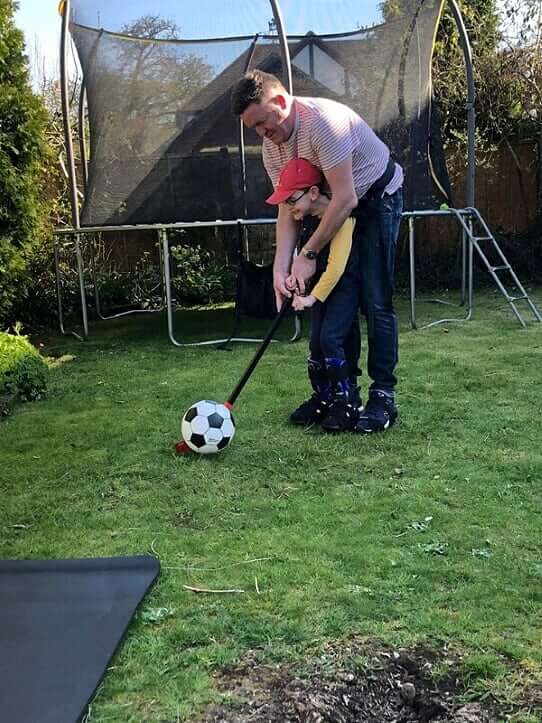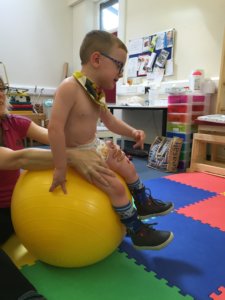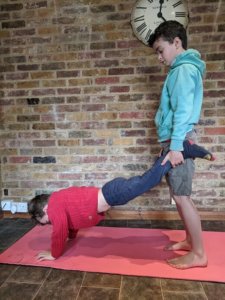29 Sports and Games to Play at Home for Children with Diplegia or Hemiplegia
Exercise is really important for health and wellbeing. It maintains cardiovascular health (preventing conditions like stroke and heart disease), boosts mental health and self-esteem, and assists our bodies in managing blood sugar and insulin levels, which can help with weight control.
Exercise also has developmental benefits for children and young people. Physically, moving the whole body improves strength, stamina, endurance, stability and mobility. Cognitive skills boosted by movement include motor planning, problem solving and bilateral integration (using the two sides of the body and brain together).
No matter what fitness level or physical abilities our child has, moving a little bit more than normal will help them get fitter and stronger. Any movement counts – it doesn’t need to be traditional sport or exercise to have a big impact.
Below, we share lots of fun ideas for active games our children can play at home. If we have more than one child in the house these games can be played in a group; however we can also play 1-1 with our child, or they can practice the skills alone.

10 super indoor sports ideas to try at home
For all of the below, you can use balloons, crumpled paper or a pair of socks to make your ball sports more house friendly.
You can set up a volleyball court with a piece of string between 2 walls in a corridor or between 2 chairs.
The aim is to make the balloon/ ball touch the floor on your opponent’s side of the string.
A corridor is great for this if your child has less accurate arm function as the walls keep the balloon in reach.
If your child has better hand/ eye coordination, and is mobile on the floor, put the 2 chairs with the string further apart so they have to move around more to retrieve the balloon/ ball.
Set up a laundry basket or draw a circle on a piece of paper and stick it to the wall or the floor for a goal.
Try to score a goal from different places – getting further away with each successful shot.
As they get more accurate you can make the goal smaller.
Set up 10 bowling pins in a triangle shape – use loo roll inners or empty plastic bottles if you don’t have skittles. Use rolled up socks, soft toys or bigger balls to start with.
Try to knock over all the skittles. See how many tries it takes to knock them down.
Get further away from the skittles or make the balls smaller as your child improves.
Try this with your child in some different positions – in their supportive chair, on their hands and knees or up high on their knees to work their muscles further.
This is a fabulous and fully inclusive sport similar to Bowles. See this Our Home video which explains how to play the game.
Dribble a balloon around the house using their hands.
You could set up an obstacle course with chairs and a goal at the end for a single child game.
For a more dexterous child, keeping the balloon in the air while they crawl around the house will keep them entertained and use up lots of energy.
This is a great game to play with siblings, Ask the sibling to mobilise the same as your child with CP to even out the game.
They have created this fantastic series for those with more profound learning needs. They use very simple language and makaton, give plenty of time for processing information and have a lovely variety of activities to try or engage with.
Here we have an example of their first exercise session:
See all their videos on their You-Tube site: https://www.youtube.com/channel/UCpx3Y7rl9HmojNnJdcfUizQ
This great series Tennis at Home done by the Lawn Tennis Association (LTA) provides simple ideas to practice your tennis skills in your back garden or in a room with a few meters of space.
If you don’t have a tennis racket you can still try these games with a fly swatter, any other kind of bat, a roll of wrapping paper or a broom. You could use socks, a balloon or scrunched up paper instead of a ball.
The activities vary in difficulty but most can be played from the wheelchair or in kneeling.
Table cricket is played by people with all disabilities. It is a great game to play with all the family and can be played using a regular table.
This video Keeping fit and healthy at home: Table top tennisgives a quick demonstration of how to set up and play table cricket in the home.
Visit this video by the Lords Taverners Lord’s Taverners | Rules of Table Cricket for more detailed explanations of how to play this great inclusive game.
This video Off The Couch – Ball skill challenge to try at home by Mickey Quinn gives some lovely and very challenging ideas of what to do with a ball to improve your ball handling skills at home. Some can be practised in sitting or kneeling but others are easier in standing.
Painters tape works well as it doesn’t leave a mark when you remove it and is colourful.
You can use tape to make targets on the wall or floor. Children can throw at/ onto the targets to practice their aim.
You can also draw out an obstacle course with the tape in a room or along your walls. This great video can give you some ideas of how to set up a tape obstacle course/ sensory path inside the home.
Maybe put this along your corridor and your whole family can follow the steps each time they go through the corridor.
This video gives lots of ideas of games to play with tape.
7 great indoor activities to try at home
Take photos of objects on your phone or tablet or print out the photos. Start by having a couple of objects in front of your child and showing a photo of 1 of them and see if they can match it to the item.
If they are able to match objects, put the object further away (within their visual range). Show the child 1 photo at a time and they need to find it in the room/ home. Make sure the objects are very desirable to keep your child engaged (e.g. favourite toy, food or a phone/tablet) and that they get to play with it once they have found it.
Once they understand the game, take photos of different things around the house and they need to go around to find the object.
Obstacle course options are endless. You want to set it up to get your child to move in as many different ways as possible. Use furniture to make your course – setting it up with the help of your child is a lovely way to get them active as they will need to carry and move furniture and objects with you. Let them come up with new obstacles as it will work their imagination. You could have themes on different days- e.g. Pirates, Beach, Jungle, Castles.
Once your obstacle course is set up, you can also add some extra stages and mark them with a piece of paper or some tape. For example:
Throw and catch a ball
Pull to stand at furniture and then get back down again.
Spinning on their bottom
Once you have set this up you can ask them to negotiate the obstacles in different ways e.g. Backwards, without bunny hopping, whilst blindfolded with someone giving instructions of how to get through the course.
Click here to have a look at our video to see how to set up a great obstacle course!
This has the added bonus of creating a space for them to play in after it is built. Provide your child with sheets and they can build a den anywhere in the house. The process of building it should mean lots of moving furniture and lifting cushions so is a great way to get them moving without realising it.
This is a great copy game. One person does an action and the other person has to copy them. This is a great way to convince your child to do any action you want from them!
Alternatively ask them to lead the game and see where their imagination takes you. If your child would struggle with this concept, try copying everything they do. If they move their arm, you move your arm the same etc. They may start moving just to make you move.
This is a great game to work visual skills. To begin with just hide an object under a piece of material in front of them so that a big part of the object is visible.. Preferably an object of interest (a phone?!) Encourage your child to pull the material away to reveal the whole object.
You can start to make this more complicated by hiding something behind a door with half of it poking out and see if they will notice/ point out or try to reveal the item. Lastly you could hide yourself, a sibling or object somewhere in the room and see if they can they go towards it.
Finally use the whole house to play the game. They could also do the hiding and you/ their sibling could look for them.
If you don’t have a parachute at home then a sheet will do the same job. Hold onto the edges between at least 3 of you. Your child can be seated or in kneeling. Put objects in the middle and make the objects move around the sheet by lifting or lowering your arms. You may need to help your child to hold on but they will get a lovely new perspective bringing the parachute up and down above and below their eye level.
Challenge your children to try and work out how to make the object jump as high in the air as possible or go around in a circle as quickly as possible.
If your child has sitting balance on the floor or on the bench/roll, you could try working some sitting balance on a moving object. This could be on a wobble cushion, on a gym ball or, if they fit on your lap, you could move your lap as a moving surface.
If using a gym/physio ball, make sure you have complete control of the ball and your child to try this – it may take 2 adults.
 If you are using the ball, you can wedge it into the corner of the room to make it more stable until you are more confident in our handling.
If you are using the ball, you can wedge it into the corner of the room to make it more stable until you are more confident in our handling.Hold your child at their hips so you have control of their bottom and the ball. Very slowly move the ball back and forward or side to side.
As they get more confident you can move in bigger movements in all directions but keep going very slowly to challenge them. Hold the position at the extreme of where they can go to make it a little harder but have a second person ready to catch them if they fall.
5 fun Sports Day Activities to try at home
Set up several balls/ socks or beanbags about 1 meter apart with a bucket/ laundry basket at the end of the line (1m away). Your child should start at the bucket end and crawl/ walk/ run to pick up the first ball/ beanbag. They should then go back to put it in the bucket.
Next crawl/ walk/ run to the second ball and go back to put it in the bucket. They should continue until all the beanbags are in the bucket.
An egg and spoon race is a great way to challenge hand eye coordination while multi-tasking.
- Use a large spoon and a small ball. The child must get from A to B without the ball falling of their spoon.
- Progress this by putting obstacles in the way.
Using a beanbag or soft toy is great for this game. Try to get from one end of the room to the other without it falling off your head.
Strong arms and hands is crucial for those with Cerebral Palsy and there is no better activity to make them work hard than wheelbarrow walking.  Start where they manage well without dropping their tummy or arching their back and go down the list as they improve.
Start where they manage well without dropping their tummy or arching their back and go down the list as they improve.
As this is such a difficult exercise you will need it to be as fun as possible so only keep going as your child is enjoying themselves. Use very enticing objects to start with – food or your phone – so they get lots of reward for their hard work.
Hold your child by their hips with their legs straddling you and their hands on the floor. Move around the floor picking up objects for as far as you can go.
Move your hands down to your child’s knees and walk around the room – picking up objects or playing a matching game or skittles.
If you can, hold your child by their ankles. Make sure they keep their bottom in the air and don’t hang their tummy’s down. Again find a game to make this more entertaining.
As your child gets stronger you could try to get from one end of the house to another – even trying going up the stairs.
You could also make an obstacle course to go around.
Use a combination of the sports day ideas above to make a great relay race around your home, each person taking their turn to complete a challenge.
7 brilliant ball games to try at home
Making a balance board is such a brilliant way to get the 2 hands working together and is also great fun.
Set up a balance board on a table or on the floor with a board and a bottle or rolling pin.
See this video for an explanation of how to play this great hand balance game.
Roll a ball between you. Start with a big ball and get smaller as your child improves.
Try to stop the ball when it comes to you before rolling back.
Try rolling with more accuracy-e.g. into a container.
Try stopping the ball with 2 Hands
Try stopping the ball with 1 hand.
Staying nice and close to each other, roll a balloon to your partner and ask them to hit it back. This is great for cause and effect as little effort goes a long way and the balloon moves slowly so gives more time to aim the hit back.
As you get better, stand further apart and launch the balloon into the air rather than along the floor.
- Use a beanbag or soft toy to practice throwing. Start with a big container or target very close to the child.
- As the child gets more accurate, move the container further away.
- You could use colours or other descriptions to throw into different containers (e.g. red toys into bucket, green toys onto the laundry basket OR dinosaurs through the hoop, farm animals into the saucepan.)
Set up a 10 pin bowling set with empty plastic bottles or stack a pyramid of empty tins.
Start very close to the target.
Give the child a large soft ball or soft toy to throw.
Encourage them to get more accurate by seeing how many throws it takes to knock them all over.
As your child gets more accurate, move the target further away.
You could also set up a points system by drawing a target on some cardboard and fix to the door or on the floor. You could also use bits of paper or post it notes on the wall as more difficult targets-the higher and smaller the target, the higher the points. You could also put letters on the targets so your child can spell out a word.
Give your child a bucket. This could rest on the floor or tray in sitting or in their arms.
Throw a beanbag or other soft toy into the air and they need to move the bucket to catch it.
As they get better, make the bucket or container smaller so they have to increase their accuracy.
You could also make the ball small or harder for an extra challenge.
Start with a big soft ball and standing/ sitting very close together. Roll the ball into the child’s hands so they get used to holding it and balancing the ball between 2 hands.
Ask the child to throw it back and keep practicing until they are accurate to you at a very small distance.
Start moving back a little so there is a gap between you.
Start making the ball a bit smaller-soft balls and beanbags are easier to catch than fully inflated balls. If you don’t have balls at home use rolled up socks, small cushions or soft toys.
Move onto large inflated balls such as footballs and then get smaller
Progress from 2 handed catches onto 1 handed catches
Try also catching on your own-throwing into the air or against a wall.
Try moving further apart from each other one step at a time to increase the challenge. If you are feeling brave try this outside with water balloons.
Try trapping the ball/ toy/ beanbag, in the elbow, under the chin, between the shoulder and cheek, under the arm or behind the knee and then letting go. Move the object between different creases (elbow to elbow, cheek to elbow). See our video on how to do this.






